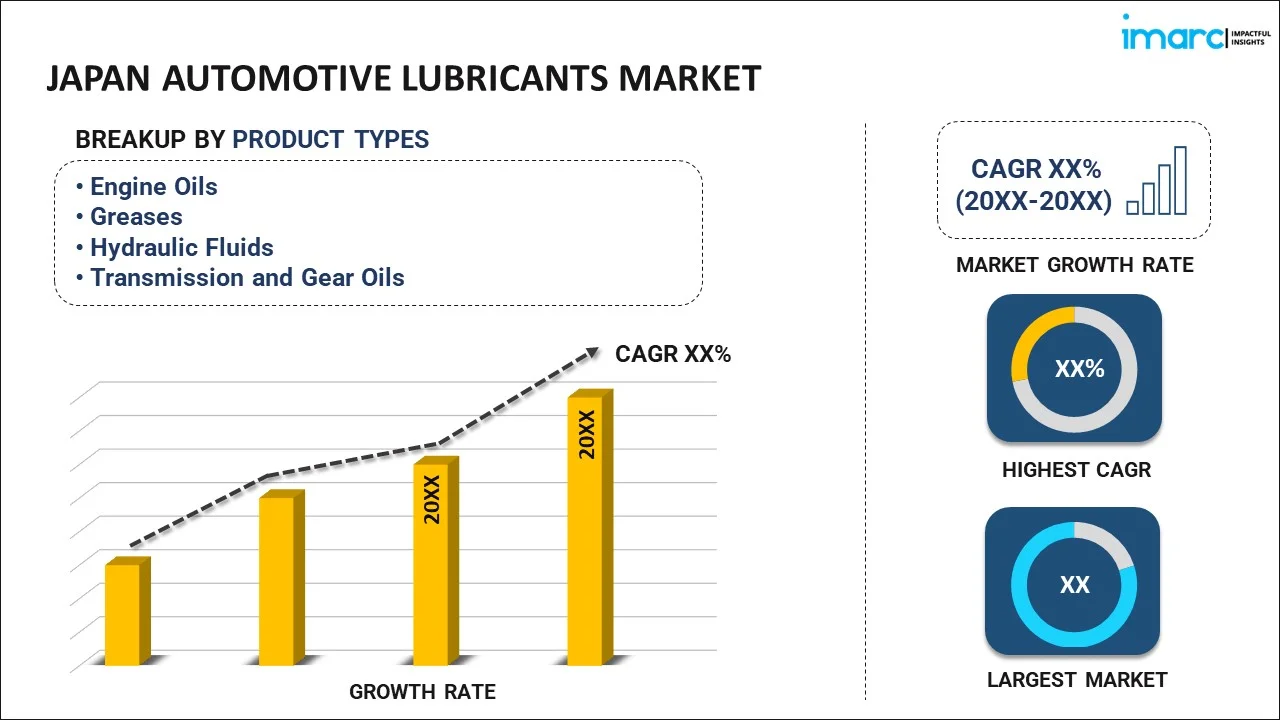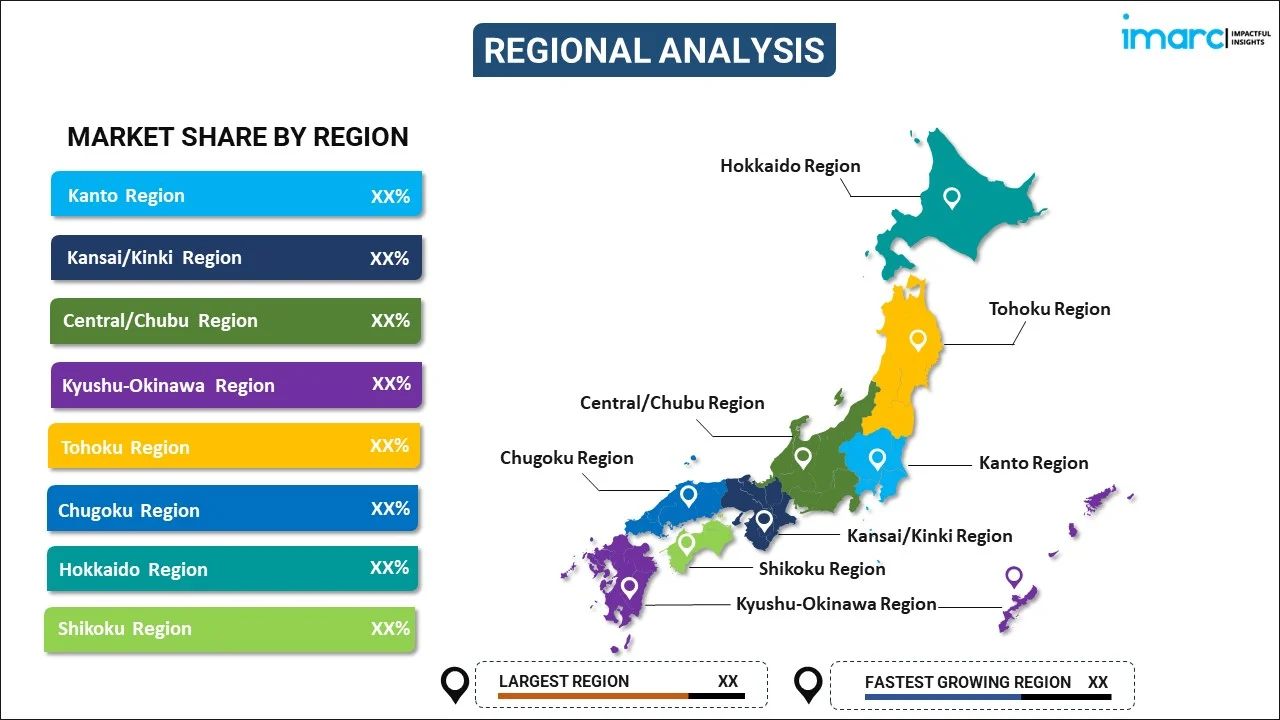
Japan Automotive Lubricants Market Report by Product Type (Engine Oils, Greases, Hydraulic Fluids, Transmission and Gear Oils), Vehicle Type (Commercial Vehicles, Motorcycles, Passenger Vehicles), and Region 2025-2033
Market Overview:
Japan automotive lubricants market size reached USD 4.3 Billion in 2024. Looking forward, IMARC Group expects the market to reach USD 5.7 Billion by 2033, exhibiting a growth rate (CAGR) of 3.2% during 2025-2033. The continuous development of chemical-free bio-based automotive lubricants, coupled with the extensive research and development (R&D) activities for improvements in oil quality are primarily driving the market growth.
|
Report Attribute
|
Key Statistics
|
|---|---|
|
Base Year
|
2024
|
|
Forecast Years
|
2025-2033
|
|
Historical Years
|
2019-2024
|
| Market Size in 2024 | USD 4.3 Billion |
| Market Forecast in 2033 | USD 5.7 Billion |
| Market Growth Rate 2025-2033 | 3.2% |
Automotive lubricants play an indispensable role in sustaining the optimal performance and longevity of automotive machinery. They are specifically formulated compounds that significantly reduce friction between moving parts in automobiles, enhancing efficiency and ensuring smooth functionality. Comprising predominantly oils and additives, these lubricants serve multiple purposes, including reducing wear and tear, preventing corrosion, cooling engine components, and maintaining cleanliness. Their relevance in the automotive industry is profound, given the continuous evolution of engine technologies and mounting demands for fuel efficiency and sustainability. The diversity in automotive lubricants is extensive, catering to numerous vehicle types, such as passenger cars, motorcycles, and heavy-duty trucks, each requiring specialized lubrication solutions. Furthermore, automotive lubricants are pivotal in mitigating the environmental impact by aiding in the reduction of emissions and enhancing fuel efficiency. By selecting the appropriate lubricant, individuals and industries can significantly extend the lifespan of vehicles, reduce repair costs, and bolster overall vehicle performance.
Japan Automotive Lubricants Market Trends:
The automotive lubricants market in Japan is propelled by a confluence of factors that collectively shape its growth trajectory. The increase in automotive production is a key driver, as rising vehicle numbers directly correlate with heightened demand for lubricants. Moreover, stringent environmental regulations mandating the use of eco-friendly lubricants have pushed manufacturers to develop innovative, low-viscosity lubricants, fostering market expansion. In addition to this, the growing popularity of electric vehicles, which has shifted the focus towards specialized lubricants for electric drivetrains and components, is also acting as another growth-inducing factor. Furthermore, the pursuit of improved fuel efficiency and reduced emissions is encouraging the adoption of advanced lubrication technologies. The expansion of emerging markets and rapid urbanization are amplifying vehicle ownership, underpinning lubricant demand. Additionally, the maintenance culture among vehicle owners, necessitating regular oil changes and lubrication services, sustains the regional market's momentum. Furthermore, the ongoing digitalization and integration of IoT (Internet of Things) technologies in vehicles that can predict maintenance practices, thereby ensuring timely lubrication, is expected to drive the Japan automotive lubricants market during the forecast period.
Japan Automotive Lubricants Market Segmentation:
IMARC Group provides an analysis of the key trends in each segment of the market, along with forecasts at the country level for 2025-2033. Our report has categorized the market based on product type and vehicle type.
Product Type Insights:

- Engine Oils
- Greases
- Hydraulic Fluids
- Transmission and Gear Oils
The report has provided a detailed breakup and analysis of the market based on the product type. This includes engine oils, greases, hydraulic fluids, transmission and gear oils.
Vehicle Type Insights:
- Commercial Vehicles
- Motorcycles
- Passenger Vehicles
A detailed breakup and analysis of the market based on the vehicle type have also been provided in the report. This includes commercial vehicles, motorcycles, and passenger vehicles.
Regional Insights:

- Kanto Region
- Kansai/Kinki Region
- Central/ Chubu Region
- Kyushu-Okinawa Region
- Tohoku Region
- Chugoku Region
- Hokkaido Region
- Shikoku Region
The report has also provided a comprehensive analysis of all the major regional markets, which include Kanto Region, Kansai/Kinki Region, Central/ Chubu Region, Kyushu-Okinawa Region, Tohoku Region, Chugoku Region, Hokkaido Region, and Shikoku Region.
Competitive Landscape:
The market research report has also provided a comprehensive analysis of the competitive landscape. Competitive analysis such as market structure, key player positioning, top winning strategies, competitive dashboard, and company evaluation quadrant has been covered in the report. Also, detailed profiles of all major companies have been provided. Some of the key players include:
- AKT Japan Co. Ltd
- Castrol Limited (BP p.l.c.)
- Cosmo Oil Lubricants Co., Ltd. (COSMO ENERGY HOLDINGS Co., Ltd.)
- ENEOS Corporation
- FUCHS
- Japan Sun Oil Company Ltd
- Motul
- Shell Lubricants Japan KK (Shell plc)
(Please note that this is only a partial list of the key players, and the complete list is provided in the report.)
Japan Automotive Lubricants Market Report Coverage:
| Report Features | Details |
|---|---|
| Base Year of the Analysis | 2024 |
| Historical Period | 2019-2024 |
| Forecast Period | 2025-2033 |
| Units | Billion USD |
| Scope of the Report | Exploration of Historical Trends and Market Outlook, Industry Catalysts and Challenges, Segment-Wise Historical and Future Market Assessment:
|
| Product Types Covered | Engine Oils, Greases, Hydraulic Fluids, Transmission and Gear Oils |
| Vehicle Types Covered | Commercial Vehicles, Motorcycles, Passenger Vehicles |
| Regions Covered | Kanto Region, Kansai/Kinki Region, Central/ Chubu Region, Kyushu-Okinawa Region, Tohoku Region, Chugoku Region, Hokkaido Region, Shikoku Region |
| Companies Covered | AKT Japan Co. Ltd, Castrol Limited (BP p.l.c.), Cosmo Oil Lubricants Co.,Ltd. (COSMO ENERGY HOLDINGS Co., Ltd.), ENEOS Corporation, FUCHS, Japan Sun Oil Company Ltd, Motul, Shell Lubricants Japan KK (Shell plc), etc. |
| Customization Scope | 10% Free Customization |
| Post-Sale Analyst Support | 10-12 Weeks |
| Delivery Format | PDF and Excel through Email (We can also provide the editable version of the report in PPT/Word format on special request) |
Key Questions Answered in This Report:
- How has the Japan automotive lubricants market performed so far and how will it perform in the coming years?
- What has been the impact of COVID-19 on the Japan automotive lubricants market?
- What is the breakup of the Japan automotive lubricants market on the basis of product type?
- What is the breakup of the Japan automotive lubricants market on the basis of vehicle type?
- What are the various stages in the value chain of the Japan automotive lubricants market?
- What are the key driving factors and challenges in the Japan automotive lubricants market?
- What is the structure of the Japan automotive lubricants market and who are the key players?
- What is the degree of competition in the Japan automotive lubricants market?
Key Benefits for Stakeholders:
- IMARC’s industry report offers a comprehensive quantitative analysis of various market segments, historical and current market trends, market forecasts, and dynamics of the Japan automotive lubricants market from 2019-2033.
- The research report provides the latest information on the market drivers, challenges, and opportunities in the Japan automotive lubricants market.
- Porter's five forces analysis assist stakeholders in assessing the impact of new entrants, competitive rivalry, supplier power, buyer power, and the threat of substitution. It helps stakeholders to analyze the level of competition within the Japan automotive lubricants industry and its attractiveness.
- Competitive landscape allows stakeholders to understand their competitive environment and provides an insight into the current positions of key players in the market.
Need more help?
- Speak to our experienced analysts for insights on the current market scenarios.
- Include additional segments and countries to customize the report as per your requirement.
- Gain an unparalleled competitive advantage in your domain by understanding how to utilize the report and positively impacting your operations and revenue.
- For further assistance, please connect with our analysts.
 Inquire Before Buying
Inquire Before Buying
 Speak to an Analyst
Speak to an Analyst
 Request Brochure
Request Brochure
 Request Customization
Request Customization




.webp)




.webp)












